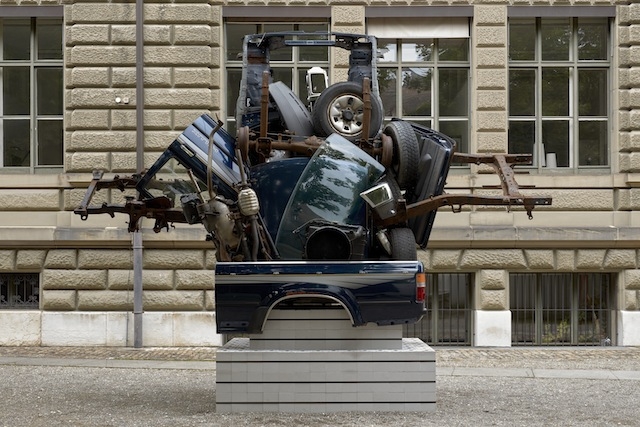Virginia Overton is presenting Untitled (2016) with White Cube. The deconstructed pick-up truck is displayed outside the Bau-und Verkehrsdepartement as part of Parcours at Art Basel 2016. Parcours aims to engage the public by placing site-specific sculptures, interventions, and performances in the city’s neighbourhoods, this year focusing on Basel’s Münsterplatz.
ArtReview The work you are making for Parcours at Art Basel involves the dismantling and reconfiguring of a pick-up truck. Can you tell us about some of the thoughts and ideas that were going through your mind when you conceived the idea for this work?
Virginia Overton I’ve made a dozen or so truck sculptures, where I’ve loaded or altered the bed of the truck on an otherwise perfectly viable vehicle; filling them with bricks, pedestals or objects found on the street; even turning a couple into light boxes, but always with the priority of dismantling the piece and then being able to use the truck again. For Parcours, I’ve taken the work a step further, and will load the truck itself into the bed of the truck; draining and dismantling the entire vehicle, rendering it useless, to do so.
AR Often the works you make are site-responsive, both in terms of finding and re-purposing local objects and materials and in how the finished work may interact with or be affected by its environment. How have you approached the site-responsive element of Parcours for this installation?
VO I visited Basel in January, walking around the town for three days with Samuel Leuenberger, the curator, looking for a location for a sculpture. There are so many amazing spots in town, it was difficult to make a choice. So, in the case for Parcours, I thought about spaces and ideas simultaneously; what could work where? In the end the combination of making a truck sculpture behind the transportation department seemed nice. I didn’t know what the sculpture would be exactly, but it was a good starting point.
AR How would you describe the significance of the idea of movement, travel or transportation to your work, in all its meanings?
VO The migration of materials is integral to the work. For instance, in my studio, I constantly make works. I live with them for a while and then often dismantle them to create new ones. So certain materials might exist in several different pieces. Similarly, I’ve made installations that are comprised of materials that then get dispersed and made into different works or installations.
AR What does it mean to show this work within the specific context of an international art fair, and what effect might its location within the Parcours site have on its perceived meaning, as opposed to if it were shown in a gallery?
VO Having a work in Parcours is an opportunity to engage a community beyond fair goers. Passersby can catch a glimpse of the sculpture as they pass by in their day-to-day activities and because this particular work is made of something so familiar it might allow viewers a new way into the work.
There is a real practicality in trucks, one of self-sufficiency. The sculptures function in this way; both pedestal and sculptural material.
AR You have used pick-up trucks in your work before, in different ways. What draws you to using this particular vehicle and how does the process of altering or breaking down its structure change your personal relationship to it?
VO There is a real practicality in trucks, one of self-sufficiency. The sculptures function in this way; both pedestal and sculptural material. They can be parked and stationary or driven, becoming kinetic. I was originally fascinated with trucks and the way people load things into the beds to simply move items from place to place, the methods of loading and securing being specific to the materials as well the distance being travelled. And the temporality of these makeshift sculptures, that they get unloaded and dispersed upon arrival at the given destination…again, the idea of migration and mobility being a key component to the idea.
AR You will have an exhibition at White Cube in London at the end of September. Can you tell us something about what the focus of either this exhibition or your next new project will be, and what is exciting you most about it?
VO Yes, the exhibition in Bermondsey opens on the 30th September. This year has been quite busy – I’ve been working from one project to the next. At this moment, I’ve just completed two solo exhibitions back-to-back, one at the Aldrich Museum in Connecticut, and another just this week at the Whitney. Now, I wake up in Basel and it’s time to make the sculpture for Parcours. The beauty of all of these shows is that the spaces are vastly different and so it lets me think about the work in different contexts and what might work best in each situation. At this moment, the show in London seems like a long time from now. I have visited the gallery a number of times and feel quite familiar with the space. But I have printed copies of the architectural plans that I travel with to take out and study when I have chance. For now, this is the part of thinking about the show and the space that I can engage with. I’m beginning to get a volumetric understanding of the place and what I could possibly do there that would make the work, the space and my energy all balance out. Let’s see.
Read more Art Basel questionnaires
Online exclusive published on 14 June 2016.
